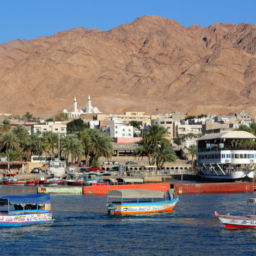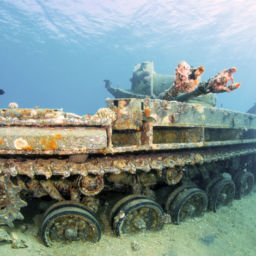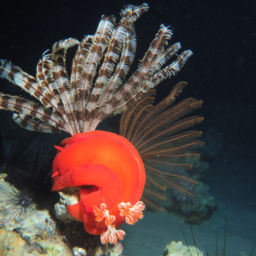There are some places you’ve seen so many times in your mind’s eye that they almost seem familiar when you finally visit. The Golden Triangle of Jordan, encompassing Wadi Rum desert, Petra, and Aqaba, was one of those places for me. Just as for many others my age, my introduction to Petra was via “Indiana Jones and the Last Crusade.” Where is that?! “Is that place real?!” I thought as I watched. It is, and it’s as glorious as I’d imagined.
But Petra is only one of the reasons to visit Jordan, a small, almost entirely landlocked country bordered by Saudi Arabia, Iraq, Lebanon and Israel. Shaped like the right side of a shirt with a bell sleeve (the sleeve’s cuff borders Iraq), Jordan has only 16 miles (27 km) of coastline, in Aqaba along the Red Sea, right at its southernmost point. Luckily for divers, though, it’s a glorious 16 miles.
In addition to diving and Petra, visitors mustn’t miss the third side of the triangle: Wadi Rum Desert. This 278 square mile (720 square kilometer) natural wonder sits just east of Aqaba, and it’s where my Jordan adventure begins.
Wadi Rum: An otherworldly landscape
It’s no coincidence that films like “Dune,” “Rogue One,” and “The Martian” use Wadi Rum desert as a backdrop to stand in for faraway desert planets. Wadi Rum means ‘valley of light,’ and with vast stretches of sand that varies from pale tan to brick red, punctuated by dramatic outcroppings of granite and sandstone cliffs, it’s easy to see how this unearthly landscape gained that moniker. Our group of travel writers and agents departs early from Aqaba for the desert, accompanied by our trip guide Khaled Elaskari.
Ahead are two days of desert hiking and stargazing. Bedouins still live in the desert here, herding their goats and sheep from place to place to follow the food, but increasingly they’re involved in the tourism industry. Jeep and camel tours crisscross the desert, shuttling tourists from canyons to dunes to rock bridges. Most, like us, spend one night at a hotel modeled after a Bedouin camp.
We spend that first day hiking across sand flats and summiting dunes with panoramic views of the desert below, replete with slow-moving camel caravans. Our first night ends at Rahayeb Desert Camp, where comfortable rooms occupy black-and-white striped Bedouin-style tents. This isn’t roughing it by any means, however — the shower is hot, and bright textiles cover the comfortable four-poster bed. The dinner spread of local specialties like hummus, falafel, pita bread, fatoush (tomatoes, cucumber and toasted pita bread) and muhammara (hot pepper dip) more than fill me up in preparation for the main event tomorrow — a 2-hour hike and rock-scramble up to the Jebel Burdah rock bridge.
Hiking up Jebel Burdah
We begin a chilly early-morning hike — I mistakenly equate “desert” with hot weather and must borrow cooler-weather gear from both Khaled and another trip-goer — to Jebel (or Jabal) Burdah, which means ‘Burdah hill or mountain.’ It’s a 2-plus hour scramble up through narrow chasms and over large boulders, and we’re all thankful for the cooler weather as we work up a sweat climbing to the spectacular rock bridge that awaits, 115 feet (35 m) up. The bridge creates an archway, framing the desert behind, and we revel in the 360-degree panoramic view of the desert below from its heights. It’s time to head into Aqaba all too soon, although I can’t say I’m not excited for the next leg of our journey: diving the Gulf of Aqaba.
Diving in the Red Sea
Although the coastline is short, the dives in Aqaba make up for the modest distance with sheer loveliness. Much of Aqaba’s diving is accessible via shore, you can reach sites by boat as well. And, if you’re staying in Aqaba proper — rather than a resort south of town — this is your best bet. There are around 20 sites in total, and we’re exploring a few of them today with Sea Breeze Dive Club, which has four hotel-based outposts around town, as well as a storefront in the city center.
We board the Aqua Breeze in front of the gleaming new Hyatt and it’s easily one of the nicest dive boats I’ve ever been on. There’s a roomy area on the main deck for dive gear and tanks, a head with a small kitchen a few steps down, and a covered area on the upper deck for lounging, which features a u-shaped settee and a table for drinks and snacks.
All the equipment on the boat is brand-new as well, which I find out when I must borrow a 5 mm wetsuit. Not only did I underestimate the chilly desert air, I also wrongly assumed the waters in the Gulf of Aqaba would be bathtub-like year-round. Instead, temperatures hover in the mid-70s (24 C) in early April when I visit.
Other than the water temperature, however, dive conditions don’t change much here. Dive sites are all essentially part of the same long coral reef that gradually slopes away from the shoreline. There’s no tide or currents to speak of, making it an ideal spot for novice divers. Khaled, who’s a certified Instructor (although he’s not diving this day because of ear trouble), tells me there is a seasonal glassfish arrival each year during May and June, but otherwise marine life remains consistent throughout the year: turtles, eels, clownfish, seahorses, tropical reef fish — all the usual suspects populate these healthy, rainbow-colored hard corals.
“Aqaba is great for beginners to learn easily in shallow waters.,” he says. “There’s no drop-off and no current so it’s really ideal. Experienced divers can get their cameras out for macro and enjoy easy diving without any movement from the current.”
Our first site for the day is the famous Japanese Garden, thusly named because many of the corals were transplanted there from further south when a Japanese company moved them rather than destroy them to build a new pier. It’s definitely reminiscent of a garden as we splash in, and I’m immediately impressed by the large, vibrant coral heads, schooling snapper and busy reef fish below. I see at least two camouflaged scorpionfish and a dozen angry but adorable clownfish, who want nothing more than for me to move away from their fiercely guarded anemone homes.
The next day we dive another famous Aqaba site — a sunken Lockheed C-130 aircraft and nearby tank. The plane, donated by the Royal Jordanian Air Force, has only been submerged since November of 2017. It sits in 40 to 56 feet (12 to 17 m) on a sandy bottom — check around the wreck for ubiquitous garden eels. We enter the wreck through one of the wide doorways cut out on both sides to accommodate divers and swim the length of the fuselage up to the cockpit.
A dive shop has installed a (fake) pilot’s skeleton in the driver’s seat but we can’t get too close on this day because three fat lionfish are his co-pilots. After exploring the plane, we fin to the nearby submerged tank for our safety stop. Sitting in only 20 feet (6 m) of water, the tank makes for a fun selfie for both divers and snorkelers. Macro life and healthy coral jam-packs nooks and crannies so we fin slowly around a few times, searching out the little stuff.
After two days on the dive boat, it’s time for the grand finale, the thing I’ve been looking forward to most since arrival: a visit to Petra.
Visiting Petra
The grand finale (at least for me) has arrived: a full day at Petra, the city carved into rosy sandstone that sits about 78 miles (126 km) from Petra. It takes about two hours to get to Petra from Aqaba, so we leave early, anticipating a busy day at this wildly popular tourist attraction.
The area was inhabited as early as 9,000 BC, and the “Rose City” was likely built starting in the 5th century BC, becoming the capital of the Nabataean Kingdom in the 4th century BC. It became a UNESCO World Heritage Site in 1985, and most of today’s visitors enter through the ¾-mile pathway at the bottom of the (1.2 km) Siq, which literally means “the shaft.” This narrow gorge features plenty to see along the way, including rock carvings, small shrines to gods, and an ingenious plumbing system wherein Nabataens funneled water from a man-made dam into the city, with one pipe for animals and one for people.
The ancient inhabitants of Petra were so good at controlling water, apparently, that they not only kept their city from suffering frequent flash floods, but also managed to store it in cisterns and dams for commercial sale. Residents largely abandoned the city after a 363 AD earthquake and it remained unknown to the west until Johann Ludwig Burckhardt rediscovered it in 1812.
We walk slowly along the Siq, taking it all in, until the iconic Al Khazneh (the Treasury) comes into view in a shaft of light before us. Despite the thick crowds of tourists, it’s still a spectacular sight in person. Camels lounge in front of the structure, which is carved directly out of the sandstone cliff face, while hawkers ask us incessantly if we need a guide to the top of a nearby cliff for a better view. You cannot go inside the Treasury — unlike Indiana Jones in the movie — but just standing outside it is awe-inspiring enough. Called ‘the Treasury’ by 19th-century Bedouins who thought surely a structure of such grandeur would hold riches, the building instead proved to be largely empty. Historians now think it may have been the mausoleum of the Nabatean King Aretas IV in the 1st century AD.
After plenty of time admiring the structure, we continue down the city’s main path, still paved in Roman stones in some places, past the ruins of an amphitheater chiseled out of stone and another large mausoleum carved into the hill, which you can enter. We don’t make it as far as the Monastery, another large structure carved into a cliff face that resembles the Treasury. With a staggering 102 square miles (264 square kilometers), it would take a lifetime to truly explore this site. One day, my companions and I agree, was just a taste. I feel that way about my entire time in the Golden Triangle of Jordan, actually. A few days in Wadi Rum, a few days underwater, and a day at Petra only strengthened my resolve to visit Jordan again.
Make it happen
You can easily get to Jordan from multiple hubs in the United States, including Chicago O’Hare and JFK. You’ll fly first to Amman before continuing on to Aqaba. After arrival, you’ll go through customs and exit the secure area. Go outside and back upstairs to the departures area; look for Gate 1, from which all Aqaba flights depart. Right before your flight is to board, you’ll go back through a small security station. The flight to Aqaba is only around 55 minutes. Companies such as our hosts, Go Aqaba, can set up any day tours and Sea Breeze Dive Club has you covered when it comes to splashing in.
Dive conditions are great for novices and experienced divers alike. Water temperatures dip down to 68 F (20 C) in the winter and climb to around 79 F (26 C) in the summer, although air temperatures from June through September can be brutal. Visibility is typically around 65 feet (20 m).
































